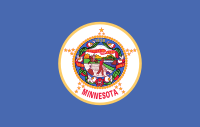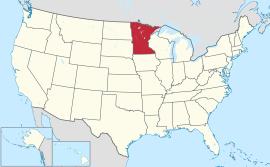Portal:Minnesota
The Minnesota Portal Minnesota (/ˌmɪnəˈsoʊtə/ MIN-ə-SOH-tə) is a state in the Upper Midwestern region of the United States. It is the 12th largest U.S. state in area and the 22nd most populous, with over 5.75 million residents. Minnesota is known as the "Land of 10,000 Lakes" but actually has 14,380 bodies of fresh water covering at least ten acres each; roughly a third of the state is forested; much of the remainder is prairie and farmland. More than 60% of Minnesotans (about 3.7 million) live in the Minneapolis–Saint Paul metropolitan area, known as the "Twin Cities", the state's main political, economic, and cultural hub and the 16th-largest metropolitan area in the U.S. Other minor metropolitan and micropolitan statistical areas include Duluth, Mankato, Moorhead, Rochester, and St. Cloud. Minnesota, which gets its name from the Dakota language, has been inhabited by various Indigenous peoples since the Woodland period of the 11th century BCE. Between roughly 200 and 500 CE, two areas of the indigenous Hopewell tradition emerged: the Laurel complex in the north, and Trempealeau Hopewell in the Mississippi River Valley in the south. The Upper Mississippian culture, consisting of the Oneota people and other Siouan speakers, emerged around 1000 CE and lasted through the arrival of Europeans in the 17th century. French explorers and missionaries were the earliest Europeans to enter the region, encountering the Dakota, Ojibwe, and various Anishinaabe tribes. Much of what is now Minnesota formed part of the vast French holding of Louisiana, which the United States purchased in 1803. After several territorial reorganizations, the Minnesota Territory was admitted to the Union as the 32nd state in 1858. Minnesota's official motto, L'Étoile du Nord ("The Star of the North") is the only state motto in French; this phrase was adopted shortly after statehood and reflects both the state's early French explorers and its position as the northernmost state in the contiguous U.S. As part of the American frontier, Minnesota attracted settlers and homesteaders from across the country. Its growth was initially based on timber, agriculture, and railroad construction. Into the early 20th century, European immigrants arrived in significant numbers, particularly from Scandinavia, Germany, and Central Europe; many were linked to the failed revolutions of 1848, which partly influenced the state's development as a center of labor and social activism. Minnesota's rapid industrialization and urbanization precipitated major social, economic, and political changes in the late 19th and early 20th centuries; the state was at the forefront of labor rights, women's suffrage, and political reform. Consequently, Minnesota is unique among Midwestern states in being a relative stronghold of the Democratic Party, having voted for every Democratic presidential nominee since 1976, longer than any other U.S. state. (Full article...) Entries here consist of Good and Featured articles, which meet a core set of high editorial standards.
 There are nineteen official symbols of the US state of Minnesota, as designated by the Minnesota Legislature. The first named symbol is the state's motto, L'Étoile du Nord – French for "Star of the North". It was selected in 1861, shortly after Minnesota achieved statehood, by the first governor, Henry Sibley, as a reflection of Minnesota's location in the Northern United States. That same year, the original state seal was adopted. Minnesota did not designate another official symbol until 1945, when "Hail! Minnesota", then the official song of the University of Minnesota, was designated as state song. In 1984, Minnesota became the first state to appoint a state mushroom, the common morel (Morchella esculenta). The newest symbols of Minnesota are the state flag and state seal, both adopted on May 11, 2024. Minnesota schoolchildren have been the force behind the successful promotion of four official symbols: the blueberry muffin (1988), the monarch butterfly (2000), the Honeycrisp apple (2006), and ice hockey (2009). The 1918 black-and-white photograph Grace, taken by Eric Enstrom in Bovey and later reproduced as a color painting by his daughter, was named state photograph in 2002. (Full article...)Selected article -The geology of Minnesota comprises the rock, minerals, and soils of the U.S. state of Minnesota, including their formation, development, distribution, and condition. The state's geologic history can be divided into three periods. The first period was a lengthy period of geologic instability from the origin of the planet until roughly 1,100 million years ago. During this time, the state's Precambrian bedrock was formed by volcanism and the deposition of sedimentary rock and then modified by processes such as faulting, folding and erosion. In the second period, many layers of sedimentary rock were formed by deposition and lithification of successive layers of sediment from runoff and repeated incursions of the sea. In the third and most recent period starting about 1.8 million years ago, glaciation eroded previous rock formations and deposited deep layers of glacial till over most of the state, and created the beds and valleys of modern lakes and rivers. (Full article...)General images -The following are images from various Minnesota-related articles on Wikipedia.
Did you know -
Related portalsTopicsLargest cities
CategoriesNew articlesThis list was generated from these rules. Questions and feedback are always welcome! The search is being run daily with the most recent ~14 days of results. Note: Some articles may not be relevant to this project.
Rules | Match log | Results page (for watching) | Last updated: 2024-05-28 21:56 (UTC) Note: The list display can now be customized by each user. See List display personalization for details.
WikiProjectsTasks
Associated WikimediaThe following Wikimedia Foundation sister projects provide more on this subject:
Sources
Discover Wikipedia using portals |














































